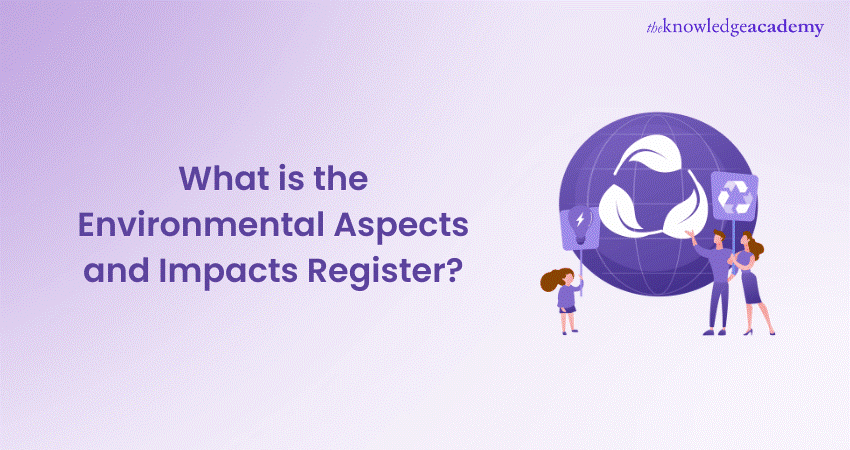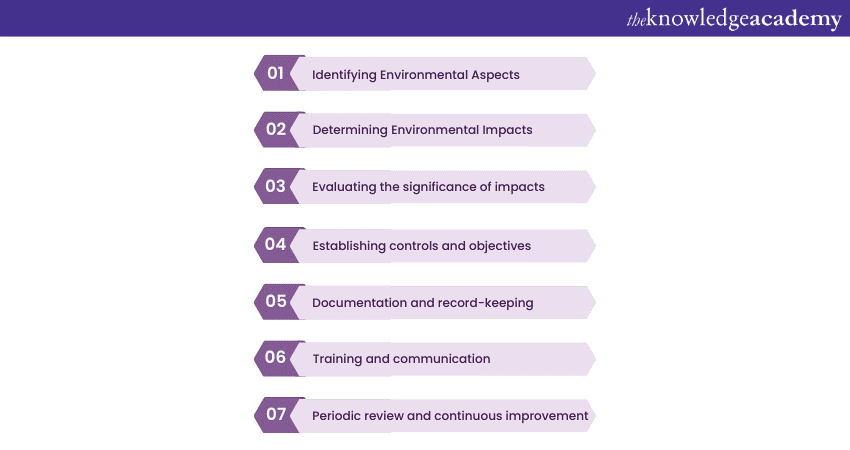We may not have the course you’re looking for. If you enquire or give us a call on 01344203999 and speak to our training experts, we may still be able to help with your training requirements.
Training Outcomes Within Your Budget!
We ensure quality, budget-alignment, and timely delivery by our expert instructors.

ISO 14001 provides a systematic approach to managing environmental responsibilities by enhancing environmental performance and achieving sustainability goals. By implementing ISO 14001, Organisations demonstrate commitment through ISO 14001 Compliance, throughout the ISO 14001 Life Cycle. highlighting the importance of the ISO 14001 Context of the organisation using ISO 14001 Software, organisations demonstrate This can be particularly done by creating and implementing the ISO 14001 Environmental Aspects and Impacts Register which serves as a key tool for identifying and managing both ISO 14001 Risks and Opportunities. In this blog, you will learn about the Environmental Aspects and Impacts Register and how it can help you improve your organisation's environmental performance. Read ahead to learn more!
Table of Contents
1) What is an Environmental Aspects and Impacts Register?
2) How to create an Environment Aspects and Impacts Register?
3) Processes, Aspects and Impacts examples
4) Best practices for maintaining an Environmental Aspects and Impacts Register
5) Benefits of implementing an Environmental Aspects and Impacts Register
6) Conclusion
What is an Environmental Aspects and Impacts Register?
An Environmental Aspects and Impacts Register is a structured tool organisations use to identify, assess, and manage the Environmental Aspects and associated Impacts of their activities, products, and services. It serves as a central repository of information, providing a comprehensive overview of the environmental considerations that must be addressed within an organisation. The Register consists of the following:
Environmental Aspects
The components and activities of an organisation that could have an impact on the natural environment and ecosystems are termed as Environmental Aspects. These Aspects include inputs, outputs or activities that are all capable of having Environmental Impacts. Some Aspects of Environmental factors are energy consumption, water usage, waste generation, emissions, use of toxic substances, and exploitation of the natural resources.
Environmental Impacts
Environmental Impacts are the environmental consequences, in terms of their positive or negative significance, that result from Environmental Aspects. These Impacts can be a marker for particular Environmental Entities, such as air quality, water quality, soil health, biodiversity and climate change. Evaluating Environmental Impacts is comprised of three components: magnitude, extent, duration, and significance.
How to create an Environment Aspects and Impacts Register?
Creating the register is a crucial step towards effective Environmental Management. The following guide should be of help to you in the process of making the Environment Aspects and Impacts Register to ensure the information is captured as is supposed to be. Let's consider the steps:

Identifying Environmental Aspects
The first step is to identify the Environmental Aspects of your organisation, including the activities, products, and services you provide. Make a deep review of all processes, operations, and inputs which interact with the environment.
Take up the issue with the relevant stakeholders' consultation, such as employees, to share ideas and thoughts. Some of the common things to consider may include energy used, water, wastes, and emission, among others.
Determining Environmental Impacts
Next, you should figure out the subsequent Impacts of Environmental Aspects. Evaluate the ways that each element could potentially influence the environment, both positive and negative. This is achieved through a thorough examination of factors like air quality, water quality, soil contamination, ecosystem destruction and natural resource degradation. Based on reliable data, scientific research, and expert knowledge, one can evaluate the extent of the Impacts well.
Evaluating the significance of Impacts
After recognising the Environmental Impacts, it is important to check their significance. Not all Impacts are equally important, and prioritisation is necessary to focus resources effectively.
Consider the magnitude, frequency, duration, and reversibility of each impact. This evaluation will help you identify the significant Aspects that substantially affect the environment and require immediate attention.
Establishing controls and objectives
According to the given sequence, develop controls as well as objectives to address the underlying Aspects and Impacts. Controls are steps and processes that can be taken to reduce or eliminate negative Impacts while maximising good ones. Goals must be Time-bound, Relevant, Measurable, Achievable, and Specific (SMART). They serve as a guide for tracking achievements and the intervention process to eliminate the environmental pollution.
Documentation and record-keeping
To keep an accurate Register, it is essential to maintain proper records and documentation. This includes ensuring that all relevant information is recorded and organised appropriately. Make sure that all relevant information is properly documented and updated on a regular basis, including specified Aspects, Impacts, and objectives. To keep things consistent and make information easier to find, use a template or structured format.
Training and communication
To ensure the effective implementation of the Register, training must be provided to employees and stakeholders involved in the Environmental Management process. They should understand the purpose of the Register, how to identify Aspects and Impacts, and their roles and responsibilities in managing them. Establish clear communication channels to inform everyone about the register's progress, updates, and changes.
Periodic review and continuous improvement
The Register is not a static document but requires periodic review and continuous improvement. Regularly check that controls and objectives are effective, noting changes to processes or activities and alter accordingly within the Register. Perform internal ISO 14001 Audit for setting the accuracy and completeness of the Register and for identifying areas for improvement. Conduct internal audits for the Register's accuracy and completeness, adhering to ISO 14001 Document Control guidelines."
Take the first step towards ISO 14001 Compliance with our ISO 14001 Foundation Course – sign up now!
Processes, Aspects and Impacts examples
The table below shows the types of processes with examples of their Aspects and Impacts:
|
Process |
Aspects |
Impacts |
|
Usage of motor vehicles in the transportation of goods |
a) Carbon dioxide emission |
a) Causes global warming |
|
Electricity generation by coal-fired power stations |
a) Extracting coal from the ground |
a) Loss of natural resources |
|
Electricity generation by wind turbines |
a) Noise when turbines are moving |
a) Noise pollution |
|
Chemical industry |
a) Wastewater |
a) Water pollution |
Best practices for maintaining an Environmental Aspects and Impacts Register
To ensure the effectiveness of your Environmental Aspects and Impacts Register, consider the following best practices:
1) Regularly evaluate and make any necessary adjustments to the register so as to include activities that your organisation may have modified or external factors which may have changed.
2) Engage employees at all levels and provide training on identifying and managing the Aspects and Impacts.
3) To improve synergy and accelerate procedures, integrate the Register with other management systems, such as quality or health and safety.
4) Communicate the Register's results and developments with all relevant parties, such as staff members, clients, authorities, and nearby residents.
5) To make sure that the information stored in the Register is complete and accurate, conduct audits on a regular basis.
Benefits of implementing an Environmental Aspects and Impacts Register
Implementing Environmental Aspects and Impacts Register offers numerous benefits for organisations, including the following:
1) Enhanced environmental performance and resource efficiency.
2) Compliance with environmental regulations and legal requirements.
3) Identification of cost-saving opportunities through waste reduction and energy efficiency.
4)Improved stakeholder trust and reputation through transparent Environmental Management.
5) Improved market competitiveness through environmental responsibility demonstration. Enhanced market competitiveness is achieved through environmental responsibility, in line with updated ISO 14001:2015 standards emphasising sustainable practices.
Want to drive sustainable change in your organisation? Sign up for our ISO 14001 Lead Auditor Course now!
Conclusion
You can use this ISO 14001 Environmental Aspects and Impacts Register to manage environmental Aspects and Impacts. The Register fundamentally guides and instructs its user in the activities required to fulfil an appropriate and adequate Environmental Management System. Once elements, significant environmental aspects and Impacts have been determined, the organisation can control them according to applicable best practices.
Enhance your organisation's Environmental Management practices with our comprehensive ISO 14001 Training - register today!
Frequently Asked Questions

Environmental impact is important to businesses since it regulates pollution, reduces expenses through green practices, and acquires funds from investors. Moreover, it will facilitate innovation and adaptability, which are essential for success in today’s dynamic market environment.

The environmental aspect and impact register is a systematically built up document which entails the analysis, evaluation and comments about the organisation's operational, product and service Impacts.

The Knowledge Academy takes global learning to new heights, offering over 30,000 online courses across 490+ locations in 220 countries. This expansive reach ensures accessibility and convenience for learners worldwide.
Alongside our diverse Online Course Catalogue, encompassing 17 major categories, we go the extra mile by providing a plethora of free educational Online Resources like News updates, Blogs, videos, webinars, and interview questions. Tailoring learning experiences further, professionals can maximise value with customisable Course Bundles of TKA.

The Knowledge Academy’s Knowledge Pass, a prepaid voucher, adds another layer of flexibility, allowing course bookings over a 12-month period. Join us on a journey where education knows no bounds.

The Knowledge Academy offers various ISO 14001 Certification, including ISO 14001 Foundation, ISO 14001 Lead Auditor, ISO 14001 Internal Auditor and ISO 14001 Lead Implementer. These courses cater to different skill levels, providing comprehensive insights into Safety Coordinator vs Safety Manager.
Our Health & Safety Blogs cover a range of topics related to ISO, offering valuable resources, best practices, and industry insights. Whether you are a beginner or looking to advance your Compliance skills, The Knowledge Academy's diverse courses and informative blogs have you covered.
Upcoming Health & Safety Resources Batches & Dates
Date
 ISO 14001 Foundation Certification
ISO 14001 Foundation Certification
Mon 17th Jun 2024
Mon 21st Oct 2024
Mon 6th Jan 2025
Mon 7th Apr 2025
Mon 4th Aug 2025
Mon 3rd Nov 2025







 Top Rated Course
Top Rated Course



 If you wish to make any changes to your course, please
If you wish to make any changes to your course, please


